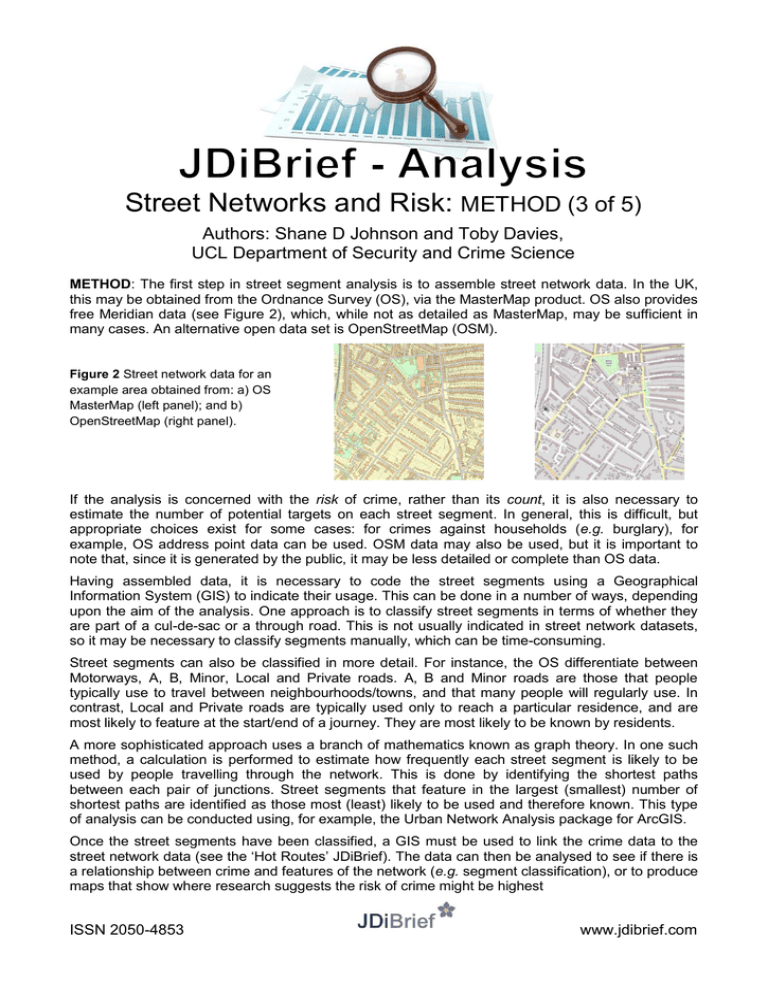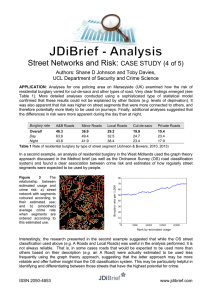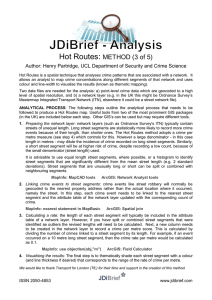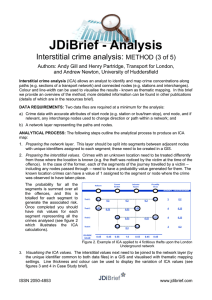Street Networks and Risk: METHOD (3 of 5)
advertisement

Street Networks and Risk: METHOD (3 of 5) Authors: Shane D Johnson and Toby Davies, UCL Department of Security and Crime Science METHOD: The first step in street segment analysis is to assemble street network data. In the UK, this may be obtained from the Ordnance Survey (OS), via the MasterMap product. OS also provides free Meridian data (see Figure 2), which, while not as detailed as MasterMap, may be sufficient in many cases. An alternative open data set is OpenStreetMap (OSM). Figure 2 Street network data for an example area obtained from: a) OS MasterMap (left panel); and b) OpenStreetMap (right panel). If the analysis is concerned with the risk of crime, rather than its count, it is also necessary to estimate the number of potential targets on each street segment. In general, this is difficult, but appropriate choices exist for some cases: for crimes against households (e.g. burglary), for example, OS address point data can be used. OSM data may also be used, but it is important to note that, since it is generated by the public, it may be less detailed or complete than OS data. Having assembled data, it is necessary to code the street segments using a Geographical Information System (GIS) to indicate their usage. This can be done in a number of ways, depending upon the aim of the analysis. One approach is to classify street segments in terms of whether they are part of a cul-de-sac or a through road. This is not usually indicated in street network datasets, so it may be necessary to classify segments manually, which can be time-consuming. Street segments can also be classified in more detail. For instance, the OS differentiate between Motorways, A, B, Minor, Local and Private roads. A, B and Minor roads are those that people typically use to travel between neighbourhoods/towns, and that many people will regularly use. In contrast, Local and Private roads are typically used only to reach a particular residence, and are most likely to feature at the start/end of a journey. They are most likely to be known by residents. A more sophisticated approach uses a branch of mathematics known as graph theory. In one such method, a calculation is performed to estimate how frequently each street segment is likely to be used by people travelling through the network. This is done by identifying the shortest paths between each pair of junctions. Street segments that feature in the largest (smallest) number of shortest paths are identified as those most (least) likely to be used and therefore known. This type of analysis can be conducted using, for example, the Urban Network Analysis package for ArcGIS. Once the street segments have been classified, a GIS must be used to link the crime data to the street network data (see the ‘Hot Routes’ JDiBrief). The data can then be analysed to see if there is a relationship between crime and features of the network (e.g. segment classification), or to produce maps that show where research suggests the risk of crime might be highest ISSN 2050-4853 www.jdibrief.com








